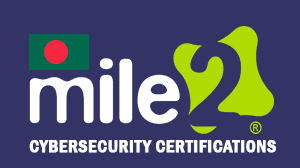Certified Professional Ethical Hacker – C)PEH
Master ethical hacking techniques with the Certified Professional Ethical Hacker (C)PEH course. Gain hands-on experience in penetration testing, cyber threat analysis, and security countermeasures. Enroll today to advance your cybersecurity career!
Overview
The Certified Professional Ethical Hacker (C)PEH course is a comprehensive training program designed to equip cybersecurity professionals with the skills needed to think and act like a hacker—ethically! This course covers advanced penetration testing techniques, vulnerability assessment, exploitation methodologies, and security countermeasures. Participants will gain hands-on experience in ethical hacking tools and methodologies to identify and secure network infrastructures from cyber threats.
Learning Outcomes
By the end of this course, participants will be able to:
✅ Understand ethical hacking principles and cybersecurity frameworks
✅ Conduct penetration testing and vulnerability assessments
✅ Identify and exploit security weaknesses in networks, web applications, and systems
✅ Utilize ethical hacking tools to simulate cyberattacks
✅ Develop countermeasures to protect against cyber threats
✅ Implement security best practices to enhance network security
✅ Gain real-world experience through hands-on labs and exercises
Detailed Outline:
Module 1 – Introduction to Ethical Hacking
- What and Why?
- Differences
- Security Definitions
- Risk Management
- Methodologies
Module 2 – Linux Fundamentals
- Core Concepts
- The shell and other items you need to know
- Managing users
- Basic Commands
Module 3 – Protocols
- Network Models
- Protocols & Services
Module 4 – Cryptography
- Understanding Cryptography
- Symmetric Encryption
- Asymmetric Encryption
- Hashing
- Cryptography in Use
- Crypto Attacks
Module 5 – Password Cracking
- What and Why
- Attacks and Tools of the Trade
- Countermeasures
Module 6 – Malware
- DOS & DDOS
- Viruses & Backdoors
- Trojans and Backdoors
- Ransomware
Module 7 – Security Devices
- Basic Security Elements
- Security Appliances
Module 8 – Information Gathering
- What are we looking for?
- Where/How do we find this information?
- Are there tools to help?
Module 9 – Social Engineering
- Social Engineering Types
- Phishing Scams
Module 10 – Reconnaissance
- What are we looking for?
- Port Scanning
- Are there tools to help?
- Banner Grabbing
- Enumeration
Module 11 – Vulnerability Assessment
- What is a Vulnerability Assessment
- Tools of the Trade
- Testing Internal and External Systems
Module 12 – Network Attacks
- Sniffing Techniques
- Hijacking
Module 13 – Hacking Servers
- Servers, What are they good for?
- What is an Exploit?
- Tools of the Trade
Module 14 – Hacking Web Technologies
- OWASP Top 10
- SQL Injection
- XSS
Module 15 – Hacking Wireless Networks
- Wireless Technologies
- Mobile and IoT Technologies
- Various Tools Used
- Hacking Techniques
- Countermeasures
Module 16 – Maintaining Access and Covering Tracks
- Maintaining Access
- Covering Tracks
Detailed Labs Outline:
Lab 1 – Intro to C)PEH Setup
- Recording Ips and Logging into VMs
- Joining the Domain
Lab 2 – Linux Fundamentals
- Command Line Tips and Tricks
- Linux Networking for Beginners
- Using FTP during a Pentest
Lab 3 – Understanding Protocols
- Analyze http session
Lab 4 – Cryptography Lab
- Hashing Data of all Sorts
- The Basics of Cryptographic Algorithms
Lab 5 – Password Cracking
Lab 6 – Malware
- Creating a virus
- Beast Trojan
Lab 7 – Information Gathering
- Google Queries
- Searching Pastebin
- Maltego
- People Search Using the Spokeo Online Tool
- Recon with Chrome
- Nslookup
Lab 8 – Information Gathering – Active Reconnaissance
- Scanning with Nmap
- Scanning with Hping
- Banner Grabbing
- Enumerating a local System with Hyena
- SMTP Enumeration
- Ad Enumeration
Lab 9 – Vulnerability Assessment
- Vulnerability Assessment with Nessus
- Vulnerability Assessment with Saint
Lab 10 – Network Sniffing/IDS
- Sniffing Passwords with Wireshark
- Performing MtM with Cain
- Performing MtM with sslstrip
Lab 11 – Windows Hacking
- Attack Windows 7 with Client-Side Exploit
- Windows 2012 Reverse TCP Exploit
- Cracking with John the Ripper
Lab 12 – Attacking Databases
- Attacking MySQL Database
- Manual SQL Injection
Lab 13 – Attacking Web Applications
- Attacking with XSS
- Attacking with CSRF
Lab 13 – Backdoors
- Setting up a Backdoor
Requirements
- Mile2’s C)SP
- 12 months of IT Experience
- 12 Months of Basic knowledge of networking and cybersecurity
- Familiarity with operating systems (Windows & Linux)
Features
- Hands-on training with real-world hacking scenarios
- Comprehensive coverage of ethical hacking, penetration testing, and cyber defense
- Live labs and real-world simulations for practical experience
- Expert-led instruction with industry-recognized curriculum
- Globally recognized certification for career advancement
- Focus on legal & ethical hacking practices
Target audiences
- Ethical Hackers & Penetration Testers
- Cybersecurity Analysts & Engineers
- SOC Analysts & Security Consultants
- Network Administrators & System Administrators
- IT Professionals Seeking Cybersecurity Careers
- Government & Military Cybersecurity Teams


